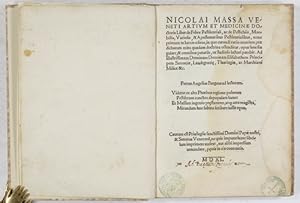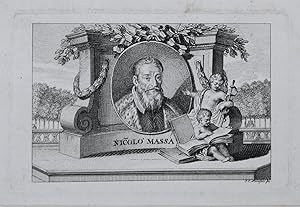massa niccolò (4 Ergebnisse)
Produktart
- Alle Produktarten
- Bücher (3)
- Magazine & Zeitschriften
- Comics
- Noten
- Kunst, Grafik & Poster (1)
- Fotografien
- Karten
-
Manuskripte &
Papierantiquitäten
Zustand
- Alle
- Neu
- Antiquarisch/Gebraucht
Einband
- alle Einbände
- Hardcover (3)
- Softcover
Weitere Eigenschaften
- Erstausgabe (1)
- Signiert
- Schutzumschlag
- Angebotsfoto (3)
Land des Verkäufers
Verkäuferbewertung
-
Saggio istorico sopra l'origine, e i progressi dell'Astronomia.
Verlag: Dedicato alla Maestà di Maria Carolina d'Austria, regina delle Sicilie. Napoli, nella Stamperia Reale, 1783. [Legato con:] TOALDO, Giuseppe. Saggi di studj veneti (sull'Astronomia). In Venezia, per Gaspare Storti, 1782,, Napoli, 1783
Anbieter: Libreria Antiquaria Pregliasco, Torino, Italien
Zustand: molto buono. in-8, 2 opere in un tomo, pp. 142; 61, (3) di errata, una tavola incisa di figure geometriche ripiegata in fine. Leg. coeva in m. pelle ed angoli, titolo e fregi in oro al dorso. La prima opera è un excursus storico sulle osservazioni astronomiche, dal Diluvio biblico fino all'invenzione dell'Equatoriale Universale ad opera di Ramsden. La seconda opera racchiude tre studi dedicati ai meriti astronomici dei veneziani, particolarmente nel campo della navigazione. Trattati non comuni. Houzeau et Lancaster, Bibliogr. Astronomie, I, 35100 descrive solo i Saggi del Toaldo). Book.
-
Liber de morbo Gallico: noviter editus: in quo omnes modi possibiles sanandi ipsum: mira quadam & artificiosa doctrina continentur: . Addita est epistola ad eximium Thomam Cademustum in qua quamplurima ad perfectionem operis totius, & multarum aliarum egritudinum curam leguntur.(Colophon: Venice, Francesco Bindoni, Maffeo Pasini, May) 1536. 4to. With title in a woodcut architectural border showing 4 charming monsters, 6 sentries and a winged putto. 19th-century panel-stamped and blind-tooled parchment.
Anbieter: Antiquariaat FORUM BV, Houten, Niederlande
Erstausgabe
50, [1], 1 blank] ll.Third(?) edition, by the printers and publishers of the first, of a famous treatise on syphilis by the Italian physician Niccolò Massa (1489-1569), professor of anatomy in Venice. It stresses the important role sexual intercourse plays in the contraction of syphilis, though he also believes it could arise spontaneously without sexual contact. He gives a comprehensive description of the symptoms and effects of the so-called French disease (the French sometimes called it the Neapolitan disease), including its neurological manifestations, and discusses the role of diet, sleep and exercise, together with the use of drugs, bloodletting, leeches and guaiac in the treatment of syphilis. The first edition is dated 1507, but was actually published in 1527. It is Massa's best-known work and remained popular throughout his life.With numerous early manuscript annotations in the margins. These have been attributed to the pioneering French surgeon Ambroise Paré (ca. 1510-1590) but we have not confirmed the attribution. With the title-page border and some of the manuscript annotations very slightly shaved, but otherwise in good condition, with some water stains in the lower inside corner of the last 3 quires and a darker marginal stain in the last. The binding is rubbed and the boards slightly warped.l Durling 2993; Hirsch IV, 160; ICCU (9 copies); Waller 6300.
-
Liber de febre pestilentiali, ac de pestichiis, morbillis, variolis, & apostematibus pestilentialibus.
Erscheinungsdatum: 1540
Anbieter: Antiq. F.-D. Söhn - Medicusbooks.Com, Marburg, Deutschland
Buch
Venise: Francesco Bindoni & Maffeo Pasini, 1540, Kl.-4°, 76 ff., feiner Pappband. Rare First Edition of the "Liber de febre pestilentiali, ac de pestichiis, morbillis, variolis, & apostematibus pestilentialibus. Venetiis, apud Franciscum Bindonem, & Maphaeum Pasinum maxima diligentia excussum. Mense Iulii. Anno a Virgineo Partu. M. D. XL. With early inscription "Ad Baptista Zucculii usum" on title-page and in probably the same hand "Costo [undeciphered] 25. bononie 1579 die 21 januarii [undeciphered] 327" on free end-paper; later signature "Genesii Soncini[?] M.D." on rear free endpaper; circular censor's stamp "Prof Pietro Tonelli Censore Stati Estensi" on title and a similar stamp (name illegible), dated Regio, 1839; from Walter Pagel library (paperslip pasted on flyleaf). Niccoló Massa's (1489-1569) third publication, the "Liber de febre pestilentiali" came out in 1540, and later the opportunity presented by the epidemics in Venice in 1555-6 was seized for a reprint, it "is dedicated to Elizabeth, duchess of Hesse and princess of Saxony, largely because of her kindness toward Massa's favorite nephew, Appollonio. This work discusses the nature and treatment of plague, fever, and smallpox as well as their after-effects in the form of pockmarks and other disfigurements. Case histories are presented, such as those of Niccoló Bianchi, a seventy- year-old sailor, or Maestro Francesco Marino, a cleric of St. Anthony of Padua. Massa's own father Apollonio, "eques aequoris," died of fever (fol. 12v) when Massa was fourteen years old (i.e. in 1499); his case history is given in detail. The tragic deaths of the years 1527 and 1528 by floods and subsequent plague in Italy are referred to from an eyewitness point of view. Massa's brother Thomas also died of fever, "quo tempore nondum eram medicus," "at a time when I was not yet a physician" (fol. 13r), i.e., before 1521, when Massa was studying medicine at Venice. In 1530 a heat wave drove farmers from the fields, killing many. The inhalation of noxious vapors as a cause of disease was illustrated by the fate of those who descended to clean an old well at Venice, witnessed by Massa. Public health and the means of preserving it seem to have concerned Massa deeply, to judge from his remarks on street and canal sanitation at Venice (fol. 24v): "Civitas ab omni sorditie et immundicie purgetur." Not only the city but its immediate environs should be cleaned. Hospitals also were to be built in healthful locations. His friends, Girolamo Marcello and Vincenzo Ricci, addressed in his Introduction to Anatomy, are mentioned again at the opening of the second tractate. Here he deals in greater detail with the means of preserving an entire community from pestilence, as, e.g., preventing those infected from moving to or from the city and by strict isolation. Many foods and drugs are mentioned in his recipes, including the juice of lemons and oranges. It is in fact remarkable how much space Massa employs in the discussion of proper foods. The proper use of sexual relations, sleep, and exercise are also carefully discussed, together with the proper control of one's feelings and passions. The case history of Gaspare Butafiioco, of the district of St. Peter, who recovered from an attack of fever in the unhappy year 1527, is related; that year saw all Italy afflicted by plague. The even more detailed history of a twenty-five-year-old virgin who fell ill at the end of August, 1527, shows Massa's ingenuity in improvising treatment. Finally, his sister Vincenza and his nephew Appollonio were stricken in 1527 with pestilential fever, but recovered to live into their old age, saved by Massa's skill." L.R. Lind, Pre-Vesalian Anatomy (1975), p.170 EDITI6 CNCE 23345; Durling 2988; Wellcome I, 4105; R. Gaskell, Books from the Library of Walter Pagel, Pt. I, 71.
-
Portrait. Brustfigur nach viertelrechts in Oval umgeben von einem Sockel. Kupferstich von Johann Ernst Mansfeld.
Verlag: (Ca.1780)., 1780
Anbieter: Antiquariat Braun, Gengenbach, Deutschland
Kunst / Grafik / Poster
(Gut erhalten). Zustand: Gut. Format (Platte): 9 x 14 cm. Blattgröße: 10,5 x 15,5 cm. Auf Untersatzpapier montiert. *Niccolò Massa (1489-1569) war ein italienischer Arzt. Aufgrund zahlreicher Sektionen erlangte er neue Kenntnisse im Bereich der Anatomie und veröffentlichte Schriften zur Einführung in die Anatomie, über das Pestfieber und zur Syphilis. Sprache: Italienisch Gewicht in Gramm: 300.





